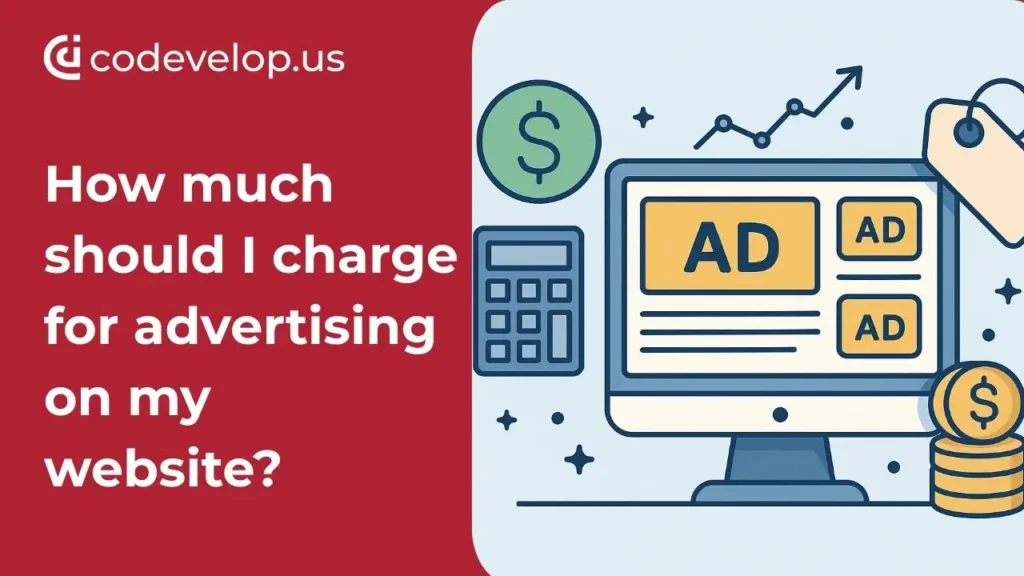Ever wondered why some website owners confidently set their ad rates while others second-guess every number they put out? Maybe you’ve built a site with steady traffic, loyal readers, or niche authority, and now brands are starting to reach out. It feels exciting… until it’s not. Because suddenly, you’re stuck with the big, uncomfortable question: “What should I charge?”
The truth is, most website owners struggle with pricing their ad space. Charge too little, and you’re leaving money on the table. Charge too much, and you risk scaring away advertisers who might have been a perfect fit. With no universal guide and every website offering different values, it’s easy to feel unsure or even overwhelmed.
That’s exactly why this guide exists. In this blog, we’ll break down how much I should charge for advertising on my website using clear, practical steps grounded in real-world logic, not guesswork. You’ll get the clarity you need to make confident pricing decisions that match your traffic, niche, and ad placement opportunities.
By the end of this post, you’ll know how to calculate fair rates, understand what advertisers actually look for, benchmark your prices against industry standards, and create ad packages that feel professional and profitable. Let’s get into it.
Key Factors That Influence Website Advertising Cost
The right price for website ads depends on several important factors. Advertisers look beyond simple metrics when deciding where to spend their money. Let’s get into what really drives your website’s ad value.
Traffic volume and engagement
Traffic numbers matter, but quality beats quantity every time. Websites with 10,000+ monthly visitors can generate substantial revenue through direct-sold advertising. A few hundred daily visitors might be enough for monetization platforms like Google AdSense.
The value of traffic engagement surpasses raw numbers. Key metrics include:
- Time spent on the page
- Bounce rates
- Clickthrough rates
- Return visitor percentages
These engagement indicators show advertisers how attentive your audience is. Each page on your site generates different revenue potential – a single page with three ad spots creates three impressions per view.
Content quality and niche relevance
Specialized content brings in premium rates. Websites in advertising-friendly niches like travel, auto, business, and healthcare attract higher-paying advertisers, regardless of their traffic volume. These industries line up perfectly with high-value audiences.
Niche publishers with targeted content often charge flat monthly rates ($500/month is common) rather than using CPM pricing. Fresh, valuable content boosts user engagement, particularly when it tackles specific questions thoroughly.
Audience demographics and behavior
Advertisers pay top rates for detailed audience data. They need to know age, income level, location, purchase intent, and online shopping history. Traffic from English-speaking countries or regions with higher spending power brings in better rates.
Your audience’s characteristics affect what you can charge by a lot. Advertisers become long-term partners and pay more when these match their ideal customer profile.
Ad placement and page design
Strategic ad placement boosts value substantially. Prime positions (like above-the-fold content) earn higher rates because they increase visibility and audience engagement. Ad viewability metrics directly influence performance and value.
On top of that, your site’s design quality plays a crucial role. A visually appealing, well-laid-out website with intuitive navigation draws premium advertisers. Mobile responsiveness is essential – pages must display properly on all devices.
Your page load speed affects both user experience and ad performance. Slow pages drive visitors away and reduce your ad inventory’s value.
Understanding Pricing Models for Website Ads
Your website ad earnings depend heavily on choosing the right pricing model. Let’s look at the most common ways advertisers pay for space on your site.
CPM (Cost per thousand impressions)
CPM pays you for every 1,000 ad displays, whether anyone clicks it or not. The math is straightforward – divide ad cost by impressions and multiply by 1,000. A $5 ad with 5,000 views gives you a CPM of $1.
Websites wanting steady revenue often choose this model. Large audience sites prefer CPM because payment comes from views alone, not clicks. Brand awareness campaigns benefit more from this approach than performance-focused ads.
This model has drawbacks. You might see many impressions without any engagement. Some of these views might not even come from actual people.
CPC (Cost per click)
The CPC model (also called pay-per-click) means advertisers pay only when users click their ads. Businesses focused on driving website visits or sales rather than visibility find this appealing.
Each CPC action costs more than CPM but brings better quality traffic. Google’s average search CPC stands at $2.69, while display network clicks cost $0.58 on average.
Publishers take on more risk with CPC since payment depends on clicks, not just views. The upside? Clicks often come from genuinely interested buyers who want what’s being offered.
CPA (Cost per action)
CPA takes performance pricing one step further. Payment happens only when users take specific actions after clicking – such as buying something, signing up, or downloading content.
These actions can include:
- Purchasing a product
- Filling out a form
- Downloading an app
- Subscribing to a newsletter
CPA usually offers the highest payment per conversion since advertisers pay for actual results. The catch? Publishers bear all the risk – no completed actions mean zero revenue.
Flat rate pricing
Small and medium publishers often choose flat-rate pricing by charging fixed monthly fees for ad space. Rather than tracking metrics, you might set a $500 monthly rate for banner placement.
Both parties benefit from stability with this approach. Publishers know their monthly earnings, while advertisers can predict their costs.
Niche websites with engaged audiences see great results with flat-rate pricing. Revenue might be lower during high-traffic periods, but this model protects against slow season drops.
Performance Metrics That Impact Ad Rates
Performance metrics play a crucial role in determining ad prices on your website. You can set competitive rates that attract advertisers and maximize earnings by tracking these metrics.
Clickthrough rate (CTR)
CTR shows the ratio of people who click your ads versus those who see them. You can calculate it by dividing clicks by impressions and multiplying by 100. A 4% CTR means 4 out of 100 viewers clicked your ad.
Industry standards show significant variation:
- Search ads: 3-5% average CTR
- Display ads: 0.5-1%
- Facebook ads: 1.1%
- LinkedIn ads: 0.4%
Better ad relevance and participation lead to higher CTRs. This results in better Quality Scores and lower costs for advertisers. Sites with above-average CTRs can charge premium rates.
Conversion rate
This metric reveals how many visitors complete desired actions after clicking an ad. You can calculate it by dividing conversions by total visitors and multiplying by 100.
Standard conversion rates differ by purpose:
- E-commerce: 2-5% standard
- Lead generation: 5-10% average
- Paid search: can exceed 10%
High conversion rates signal quality traffic to advertisers. Your site can command higher prices when it delivers conversions above industry standards.
Ad viewability and fill rate
Ad viewability measures actual human views of ads. IAB standards define a viewable ad when 50% of pixels appear for at least one second.
The data shows that 56% of display ads never reach human eyes. Advertisers now prefer viewable CPM (vCPM) over traditional metrics.
Revenue depends on the fill rate, the percentage of fulfilled ad requests. Low fill rates represent missed money-making opportunities.
Monthly page views and reach
Your revenue potential ties directly to traffic volume. Here’s what you can expect:
- 500,000 monthly page views can bring in $1,000-$5,000
- 1 million monthly page views typically yields $2,500-$25,000
More engaged visitors mean higher earnings. Small sites with 2 million monthly page views can generate $600,000 annually. This proves that traffic quality matters as much as quantity.
Steps to Calculate How Much to Charge for Ads
Let’s walk through the practical steps to price your website’s ad space.
Identify your best-performing pages.
Your first step is to get into your website metrics and find your digital “hot spots.” Google Analytics shows pages with the highest “Clicks,” “Impressions,” and “CTR” (clickthrough rate). These pages will bring better rates. You should think about how many ad slots each page supports without hurting user experience. The best spots are pages where visitors spend more time or connect deeply with your content.
Compare with industry measures.
Research what others in your niche charge before setting prices. Google search ads average 3.17% CTR, while display ads hit 0.47%. The cost-per-click runs around $2.69 for search and $0.63 for display ads. Legal and finance sectors often pay premium prices because of high competition.
Estimate earnings based on CTR and CPC.
The math part is straightforward! Here’s the simple formula: Ad Revenue = Impressions × CTR × CPC
A site getting 50,000 impressions monthly, with 2% CTR and $0.75 CPC, would earn about $750. CPM models use this calculation: (Number of Impressions × CPM) ÷ 1000.
Test and adjust pricing over time
Begin with slightly lower rates to attract early advertisers. Your prices can gradually increase as you build a track record. Different pricing models with similar advertisers help find your sweet spot. Remember seasonal changes, many industries see a “summer slump” while year-end brings increased activity. Your advertisers’ feedback about rates and offerings helps refine your strategy.
Conclusion
Setting your website’s advertising rates doesn’t have to feel overwhelming. You already understand what drives ad value.
Traffic volume counts, but quality engagement matters more than raw numbers. Niche content can attract premium rates, regardless of size. Your audience’s demographics are a vital part of what advertisers will pay.
The pricing models we explored each serve different purposes. CPM works great for high-traffic sites, while CPC suits performance-focused campaigns. CPA brings the highest payouts but adds more risk to your operation. Many smaller publishers prefer flat-rate pricing for its stability.
Success comes from starting modestly and adjusting based on results. Your initial rates might range from $1-$5 per thousand impressions, depending on your niche. Track your metrics and raise rates gradually as you demonstrate value.
Try different ad placements and pricing structures with confidence. What succeeds on one site might not work on yours. Testing helps you find your sweet spot.
Quality content that serves your audience should be your primary focus. Better engagement naturally drives higher ad rates. Your site’s monetization potential grows with your audience’s trust.
You can now answer that key question: “How much should I charge for advertising on my website?” The answer lies in your unique value proposition to advertisers. How much should I charge for advertising on my website?
You’re probably wondering about the right price for advertising on your website. Don’t worry – many website owners ask the same question.
Display ads typically cost between $2 and $5 per thousand impressions, while video ads can fetch $10 to $25. These numbers might surprise you. Small businesses allocate between $300 and $5,000 monthly for their digital advertising needs.
No single formula works for everyone because website advertising costs vary significantly. Local publishers often require at least $5,000 monthly to sustain their operations. The landscape looks very different for major platforms – Facebook and Instagram command between $100,000 $450,000 daily for their front page advertising spots.
Newcomers to website advertising should consider starting with $1 to $5 per thousand impressions. Your specific rates will depend on several key factors. Traffic numbers, content quality, your audience’s demographics, and strategic ad placement all play crucial roles in determining optimal pricing.
Let’s explore how to calculate fair advertising rates for your website. This guide will help bloggers, small business owners, and content creators realize their site’s full earning potential while keeping advertisers happy.


